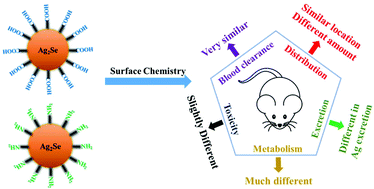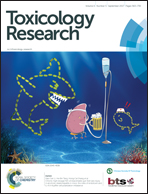Biological behaviors and chemical fates of Ag2Se quantum dots in vivo: the effect of surface chemistry†
Abstract
Ag2Se quantum dots (QDs) are novel fluorescent probes in the second near-infrared window with great imaging quality and biocompatibility. Surface modification is an essential step to disperse Ag2Se QDs into biological fluids, and endow Ag2Se QDs with diverse surface chemistry. However, the effect of surface chemistry on the biological behaviors and chemical fates of Ag2Se QDs has not been studied, which hinders the design of suitable Ag2Se QDs for biomedical applications. Here, the distribution, degradation, excretion and toxicity of 2-aminoethanethiol and mercaptopropionic acid coated Ag2Se QDs (denoted as QDs-MEA and QDs-MPA, respectively) were systematically investigated in mice for a 28-day observation period after a single intravenous injection. Ag2Se QDs with different surface chemistries displayed similar trends in all observations, such as fast blood clearance, main uptake in the liver and spleen, severe biotransformation, Ag excretion through feces, and low toxicity. The major different behaviors observed were the partially pulmonary deposition, the faster transformation at the initial stage, the lower excretion percentage, and the more obvious damage to the liver by QDs-MEA compared to QDs-MPA. The surface chemistry of Ag2Se QDs regulated their biological behaviors and chemical fates in vivo, and surface chemistry should be fully regarded when designing Ag2Se QDs for biomedical applications from the biosafety perspective.



 Please wait while we load your content...
Please wait while we load your content...